Virtual Reality Statistics By Market, Users, Age Group, Region And Facts (2025)

Updated · Jul 23, 2025

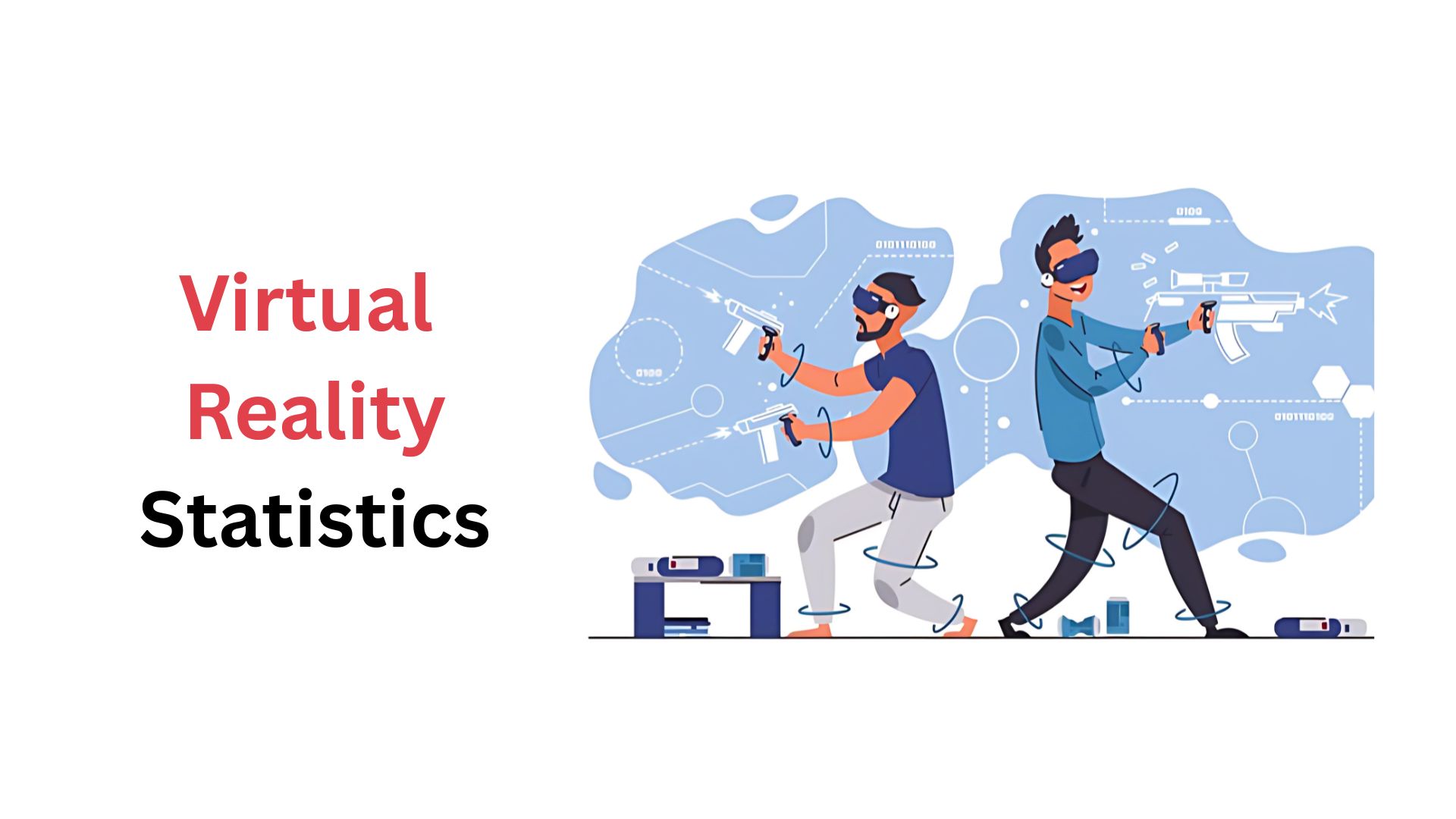
WHAT WE HAVE ON THIS PAGE
- Introduction
- Editor’s Choice
- Virtual Reality (VR) Market Size Statistics
- Virtual Reality User Statistics
- Virtual Reality Usage Statistics
- Virtual Reality Statistics by Age Group
- By Region
- Virtual Reality Users Experiencing Motion Sickness Statistics
- Virtual Reality Advertising Statistics
- Virtual Reality Software Statistics
- Virtual Reality Hardware Statistics
- Virtual Reality Adoption Statistics
- Factors Hindering VR Adoption Statistics
- VR Activities Statistics
- Virtual Reality Device Shipment Share Statistics by Vendor
- Virtual Reality (VR) Headset Statistics
- Reasons for Interacting with VR Devices – Statistics
- Complaints about Their VR Devices Statistics
- Reasons for Not Purchasing a VR Device
- Social Impact of Virtual Reality Technology Statistics
- Conclusion
Introduction
Virtual Reality Statistics: Virtual Reality (VR) is a technology that lets people step into a computer-generated world that feels real to the user. It uses special 3D screens, headsets, sensors, and motion tracking to make people feel like they are actually inside the virtual space.
In recent years, VR has been used in many areas, such as gaming, education, healthcare, real estate, military training, virtual meetings, and therapy. As the technology is becoming more advanced and affordable, VR is slowly changing the way we learn, work, and connect with the world.
This article includes several statistical analyses that will guide you in understanding the article better as it covers the overall VR market, revenue, advertising, industries used in, user bases and many other factors.
Editor’s Choice
- According to a report published by Precedence Research, the market revenue of the Virtual Reality market is estimated to reach USD 36.13 billion by the end of 2025.
- In 2024, the Asia Pacific region led with over 41% of total revenue.
- Among devices, head-mounted displays took the top spot with 60.40% share.
- Semi- and fully-immersive technologies dominated at 83%, while the hardware category contributed the most at 66%.
- When it comes to usage, commercial applications stood out, making up 56% of the market.
- The Demand Sage report states that as of 2024, more than 171 million people around the world use virtual reality technology.
- The Go Beyond report further shows that about 82% of VR users say they use virtual reality at least once a month.
- As mentioned in passport-photo. Online, around 29% of users are open to using VR for shopping.
- According to scoop.market.us, people between 25 and 34 years old make up the largest group of VR users, at 35%.
- Virtual Reality Statistics states that about 13.7% of people deal with VR frequently, while 19.1% experienced it sometimes.
- A Statista report further states that in 2025, the global VR advertising market is set to bring in about USD 178.4 million.
- In the same period, the VR Software market is expected to generate around USD 4.9 billion.
- Besides, the VR hardware market is set to reach around USD 13 billion.
- As of 2024, the cumulative installed base of VR headsets has accounted for 34.03 million unit sales, as mentioned in Smarttek. Solutions.
Virtual Reality (VR) Market Size Statistics
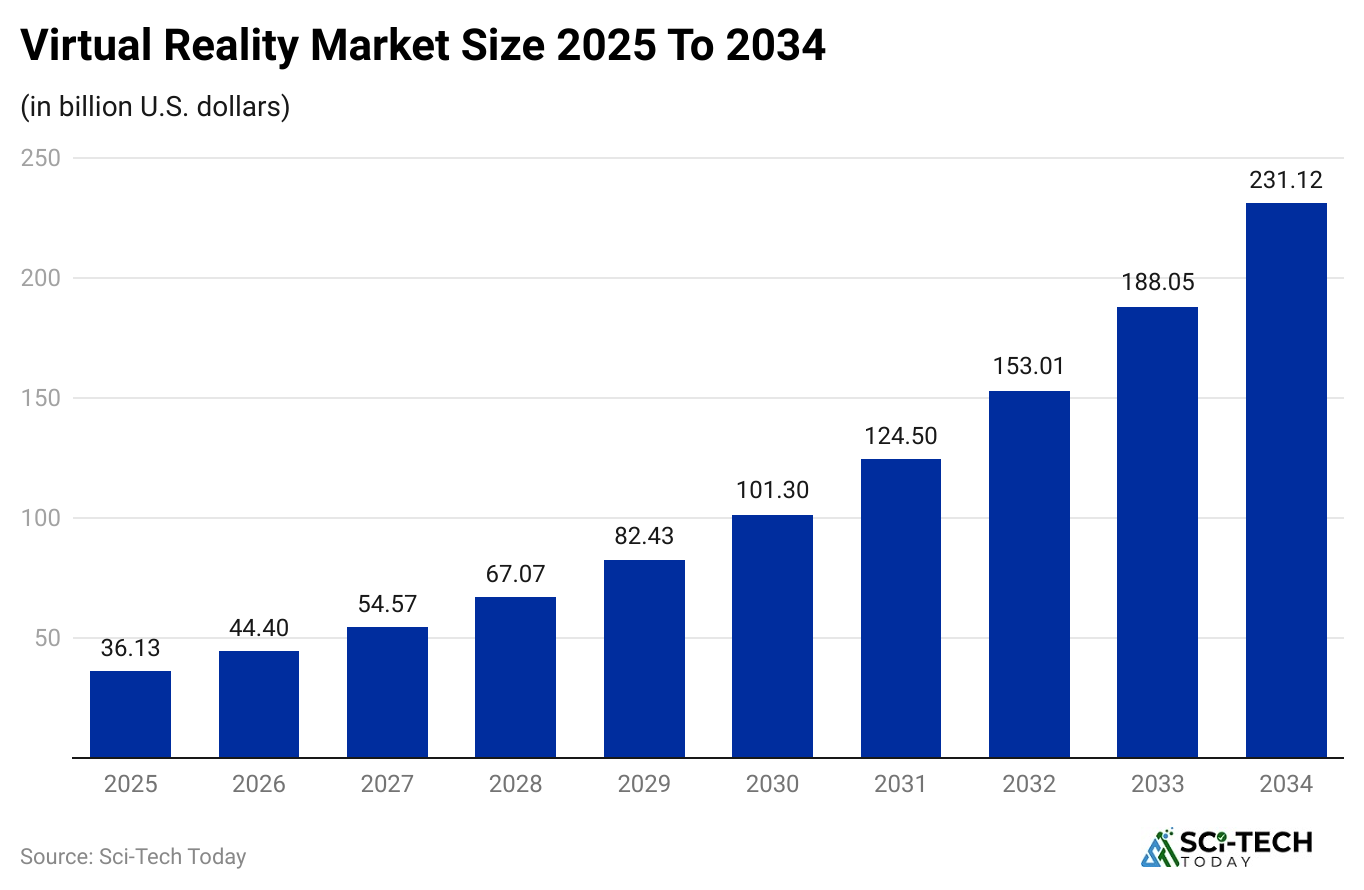
- The market revenue of the Virtual Reality market is estimated to reach USD 36.13 billion by the end of 2025.
- The expected market revenue in the coming years is going to reach 2026 (USD 44.40billion), 2027 (USD 54.57 billion), 2028 (USD 67.07 billion), 2029 (USD 82.43 billion), 2030 (USD 101.30 billion), 2031 (USD 124.50 billion), 2032 (USD 153.01 billion), 2033 (USD 188.05 billion), and 2034 (USD 231.12 billion).
- The compound annual market growth will grow at a CAGR of 22.90% from 2025 to 2034.
Virtual Reality User Statistics
- The Demand Sage report states that as of 2024, more than 171 million people around the world use virtual reality technology.
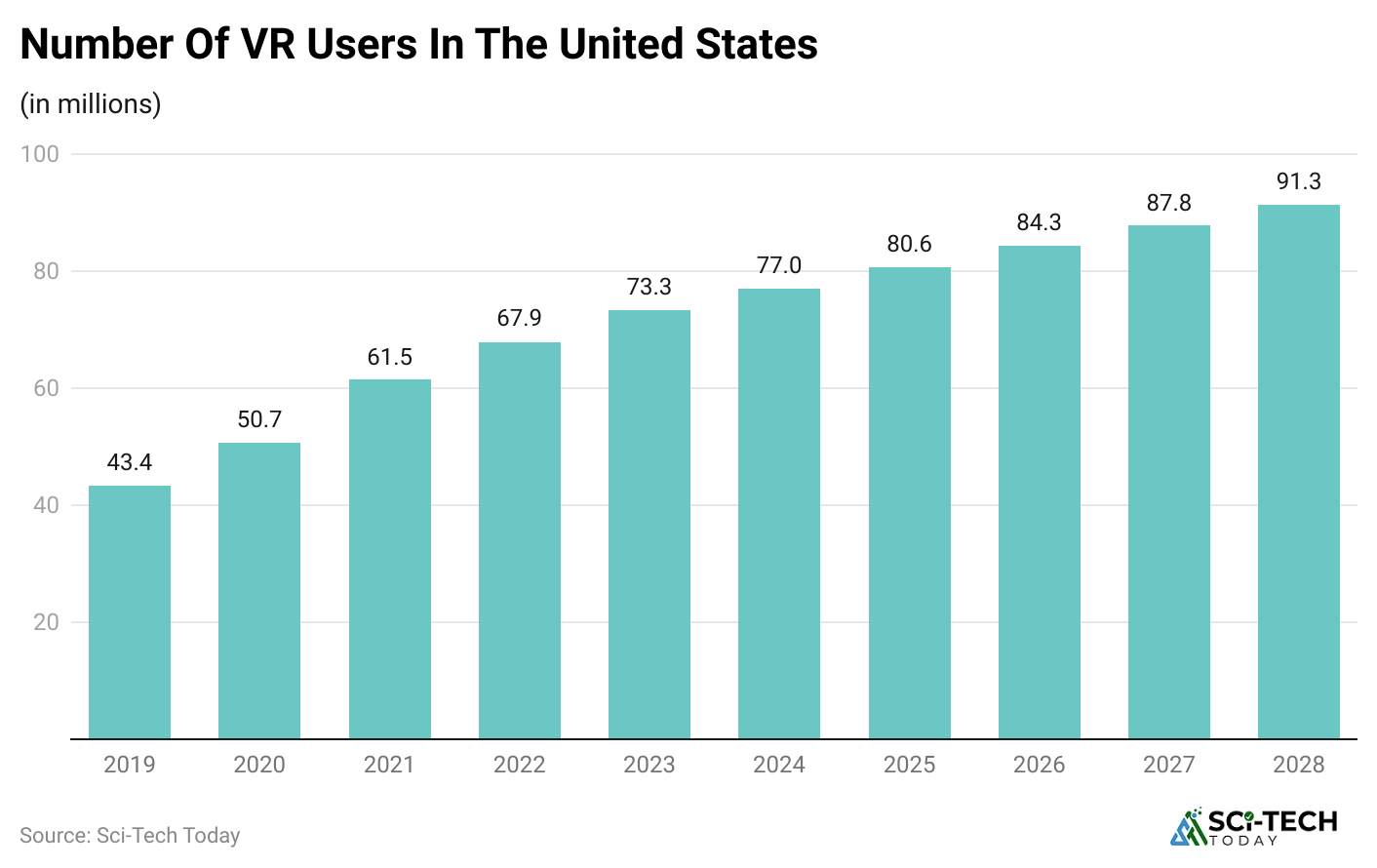
- In the same duration, in the United States alone, about 77 million people are believed to be using VR.
- By the end of 2025, the total number of VR users in the U.S. is expected to reach 80.6 million, followed by 2026 (84.3 million), 2027 (87.8 million), and 2028 (91.3 million).
- According to Statista Insight, by 2029, around 3.7 billion people are expected to use AR and VR technologies worldwide.
- In 2025, about 54.1% of the global population is projected to be using these tools, and this share is likely to grow to 56.5% by 2029.
Virtual Reality Usage Statistics
- Demand Sage report also shows that in recent years, about 91% of companies either already use VR or AR tools or are planning to start using them soon.
- Furthermore, other use cases of AR/VR by share of companies are followed by virtual supplement labour on production floors (60%), virtual customer visits (53%), design and product engineering (53%), and training employees (26%).
- 82% of adult VR users in the U.S. report using at least monthly, with many becoming repeat users.
- The Go Beyond report further shows that about 82% of VR users say they use virtual reality at least once a month.
- In addition, 70% of them feel happy or very happy with their overall VR experience.
- techtipswithtea.org states that most people use VR for playing games, which makes up 43% of its usage.
- It’s also popular for virtual travel, used by 19% of users.
- About 11% enjoy watching videos in VR, while 8% use it for fitness and exercise.
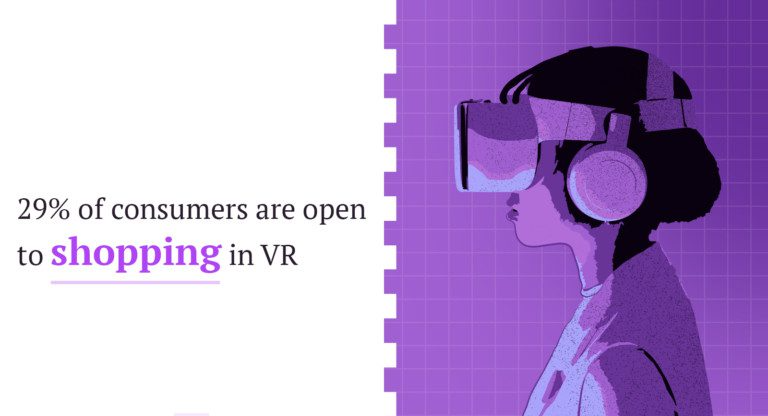
- Around 66% of people feel that VR should offer something more exciting than regular movies and games.
- About 55% say they’d consider buying a VR headset if it worked like a smartphone or tablet.
- 47% of people are too scared to try horror experiences in VR, and only 13% can use a headset for over an hour without stopping.
- Meanwhile, around 29% of users are open to using VR for shopping.
Virtual Reality Statistics by Age Group
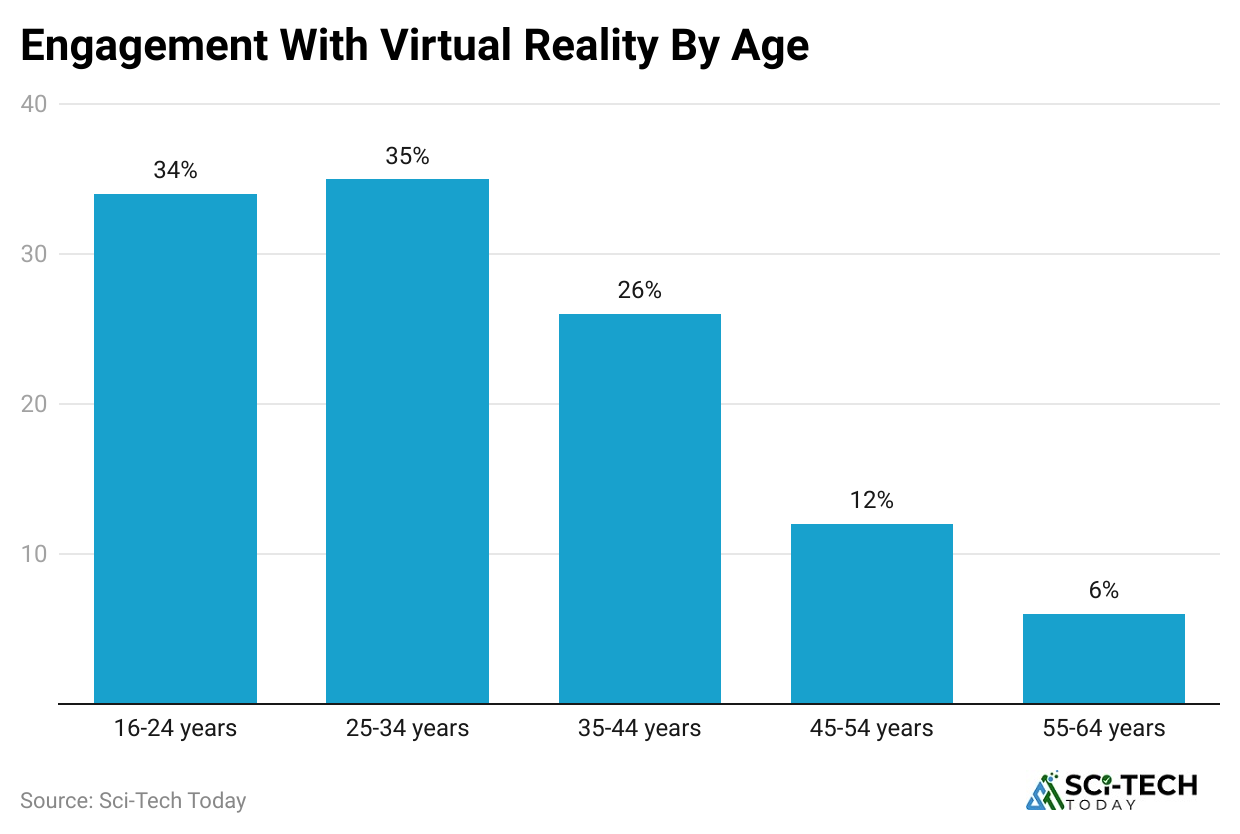
- According to scoop.market.us, people between 25 and 34 years old make up the largest group of VR users, at 35%.
- Besides, 34% of individuals aged 16 to 24 have also experienced VR.
- Meanwhile, around 26% of those in the 35 to 44 age range have tried it.
- In older groups, only 12% of people aged 45 to 54 have explored virtual reality.
- Among those over 55, just 6% have interacted with this technology at all.
By Region
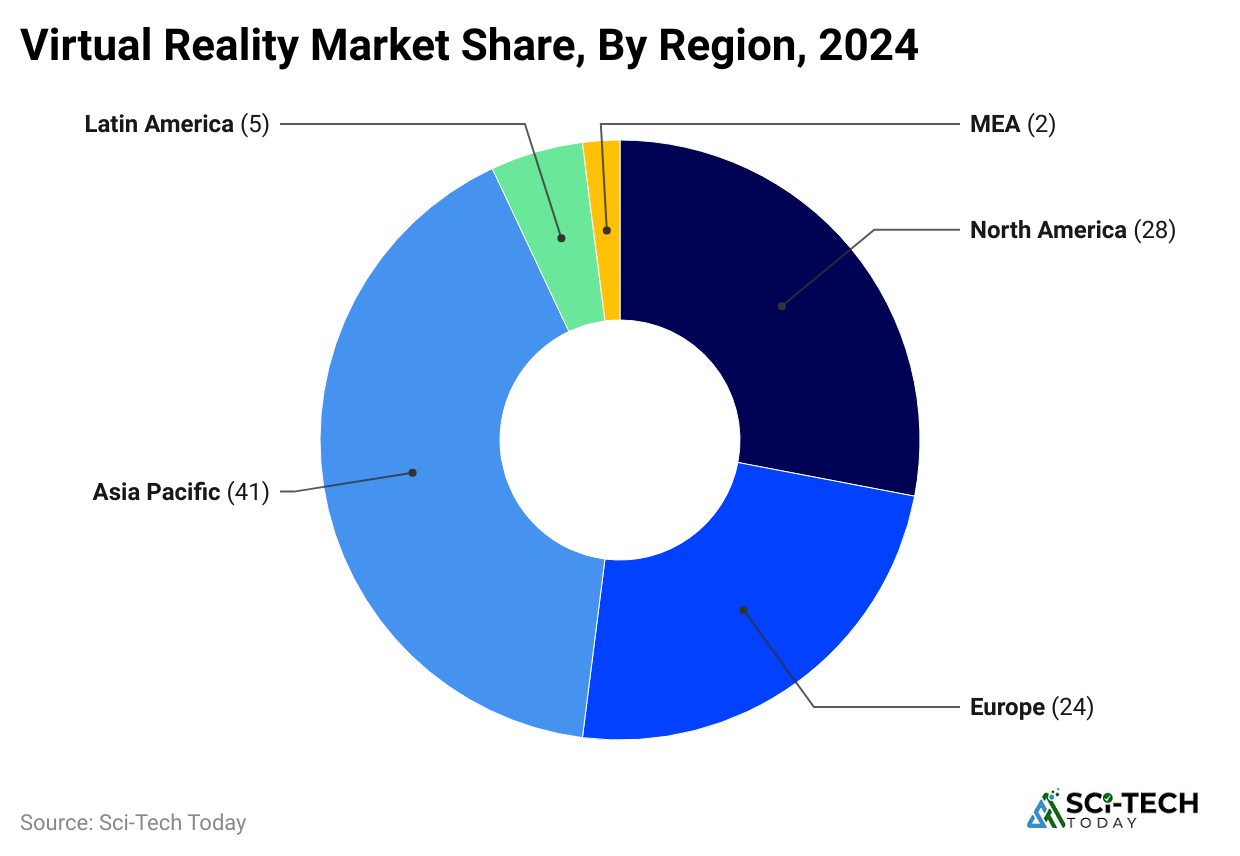
- Virtual Reality Statistics also states that in 2024, the Asia Pacific region led with over 41% of total revenue.
- The second and third highest VR market share in the same duration were captured by North America (28%) and Europe (24%).
- Followed by Latin America with a market share of 5% and MEA with 2% VR share.
Virtual Reality Users Experiencing Motion Sickness Statistics
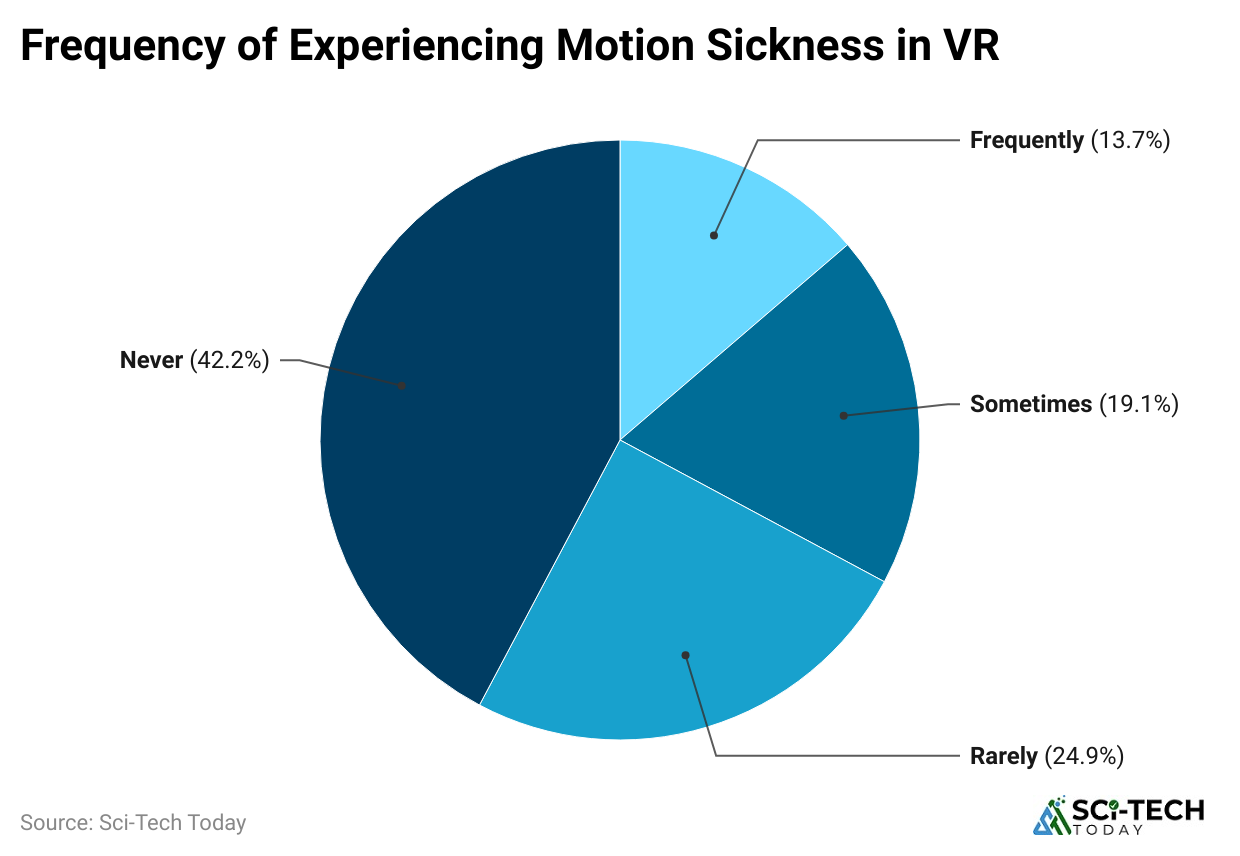
- Virtual Reality Statistics states that about 13.7% of people deal with VR frequently, while 19.1% experienced it sometimes.
- Meanwhile, another 24.9% say they face it rarely.
- In contrast, 42.2% mention they’ve never experienced it at all.
- Around 22.6% of women often feel sick while using virtual reality, while this happens regularly to only 7.2% of men.
- Meanwhile, 29% of men and 20.2% of women say they experience it only once in a while.
- Interestingly, 50% of the male users have never felt VR sickness, compared to just 34.7% of female users who can say the same.
Virtual Reality Advertising Statistics
- A Statista report further states that in 2025, the global VR advertising market is set to bring in about USD 178.4 million.
- From 2025 to 2029, it’s expected to grow by roughly 1.06% CAGR, reaching around USD186.1 million by the end of 2029.
- As of 2025, the United States will generate the highest revenue, approximately USD48.4 million.
Virtual Reality Software Statistics
- The Virtual Reality (VR) Software market is expected to generate around USD 4.9 billion in revenue by 2025, as mentioned in a Statista report.
- Over the next four years, it is projected to grow at an annual rate of 5.77%, resulting in USD 6.2 billion by 2029.
- The United States is predicted to lead in this sector, with an estimated USD 1.1 billion in revenue in 2025 alone.
- By the end of 2029, the VR software users are estimated to reach 207.4 million.
- In contrast, user adoption will reach 3.0% in 2025, slightly rising to 3.1% by 2029.
- On average, each user will generate about USD 25.6 in revenue.
Virtual Reality Hardware Statistics
- According to Statista’s report insights, by 2025, the VR hardware market will reach around USD 13 billion in revenue.
- The market is expected to grow at a CAGR of 8.24% annually, resulting in USD 17.9 billion by 2029.
- China is expected to lead the VR hardware market in 2025, generating about USD 3.4 billion in revenue.
- Globally, the number of VR hardware users is predicted to reach 167.2 million by 2029.
- The share of people using these devices is likely to grow from 2.3% in 2025 to 2.5% by 2029.
- On average, each user is expected to bring in around USD 88.7 in revenue worldwide.
Virtual Reality Adoption Statistics
- According to Demand Sage, around 51% of businesses are either using VR or planning to add it to one of their main areas.
- Also, 34% believe VR helps most with employee learning and development.
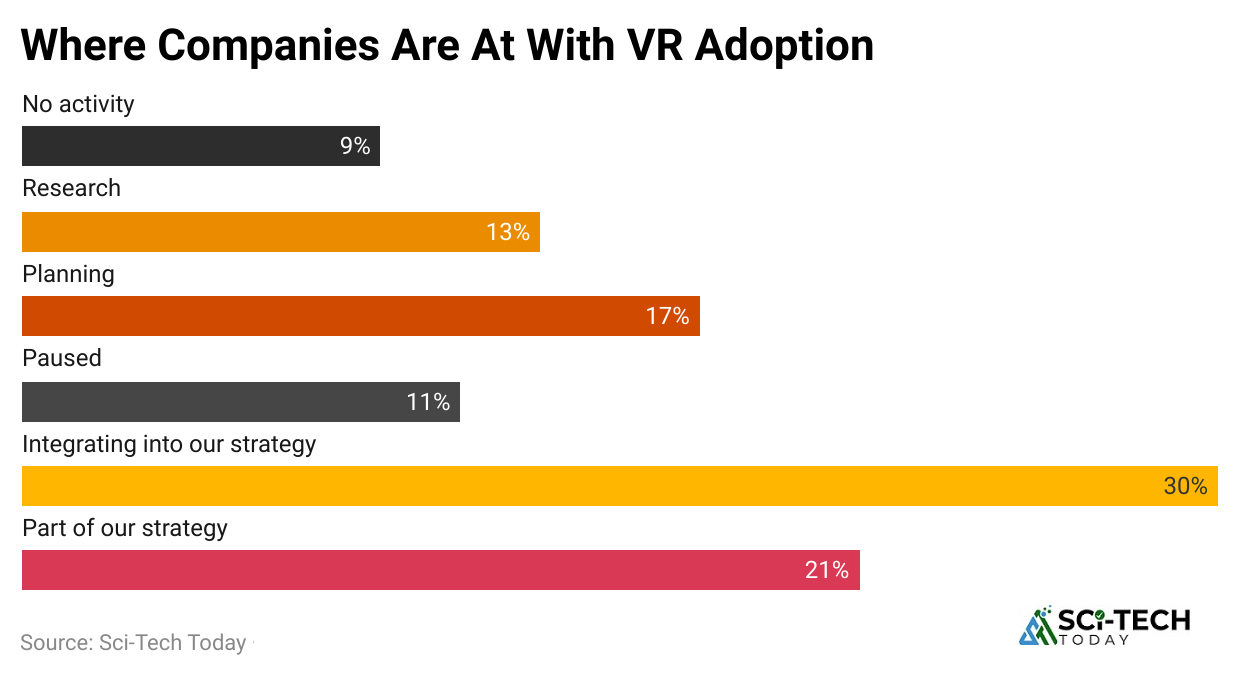
- The above survey shows how businesses are approaching Virtual Reality (VR), in which 30% are actively integrating VR into their current strategies, while 21% have already made it a part of their overall business strategy.
- Another 17% are in the early stages of planning for using it, of which 13% are researching how it could help them, and 11% have paused their efforts for now.
- In contrast, only 9% of companies haven’t started any work with VR.
Factors Hindering VR Adoption Statistics
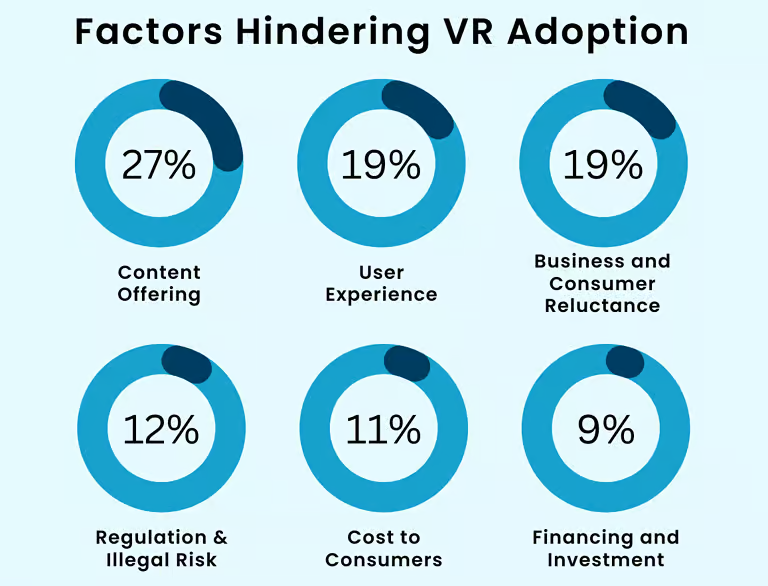
- The biggest issue is the lack of quality content, mentioned by 27% of respondents.
- Both poor user experience and hesitation from businesses and consumers follow next, each affecting 19% of users.
- Other concerns include legal and regulatory risks (12%), the high cost to consumers (11%), and limited investment or financial support (9%).
VR Activities Statistics
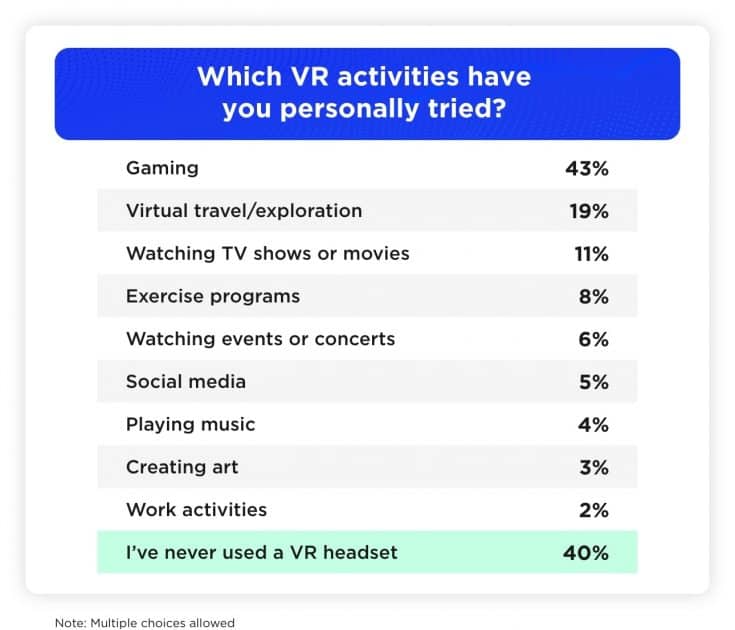
- According to the above chart, gaming is the most common VR activity, with 43% of users having tried it.
- Following that, 19% have explored virtual travel or exploration experiences, while 11% have used VR to watch TV shows or movies.
- Other activities include exercise programs (8%), watching live events or concerts (6%), and social media (5%).
- Less common uses are playing music (4%), creating art (3%), and using VR for work-related tasks (2%).
- Interestingly, 40% of respondents have never used a VR headset at all.
- A report published by scoop.market.us shows that Sony leads the VR device market, handling about 43% of global shipments.
- Furthermore, Oculus by Facebook comes next with a 19.4% share, followed by HTC at 12.9% and Microsoft with 3.2%.
- The rest of the Virtual Reality (VR) device shipment share made up a share of 21.5%.
Virtual Reality (VR) Headset Statistics
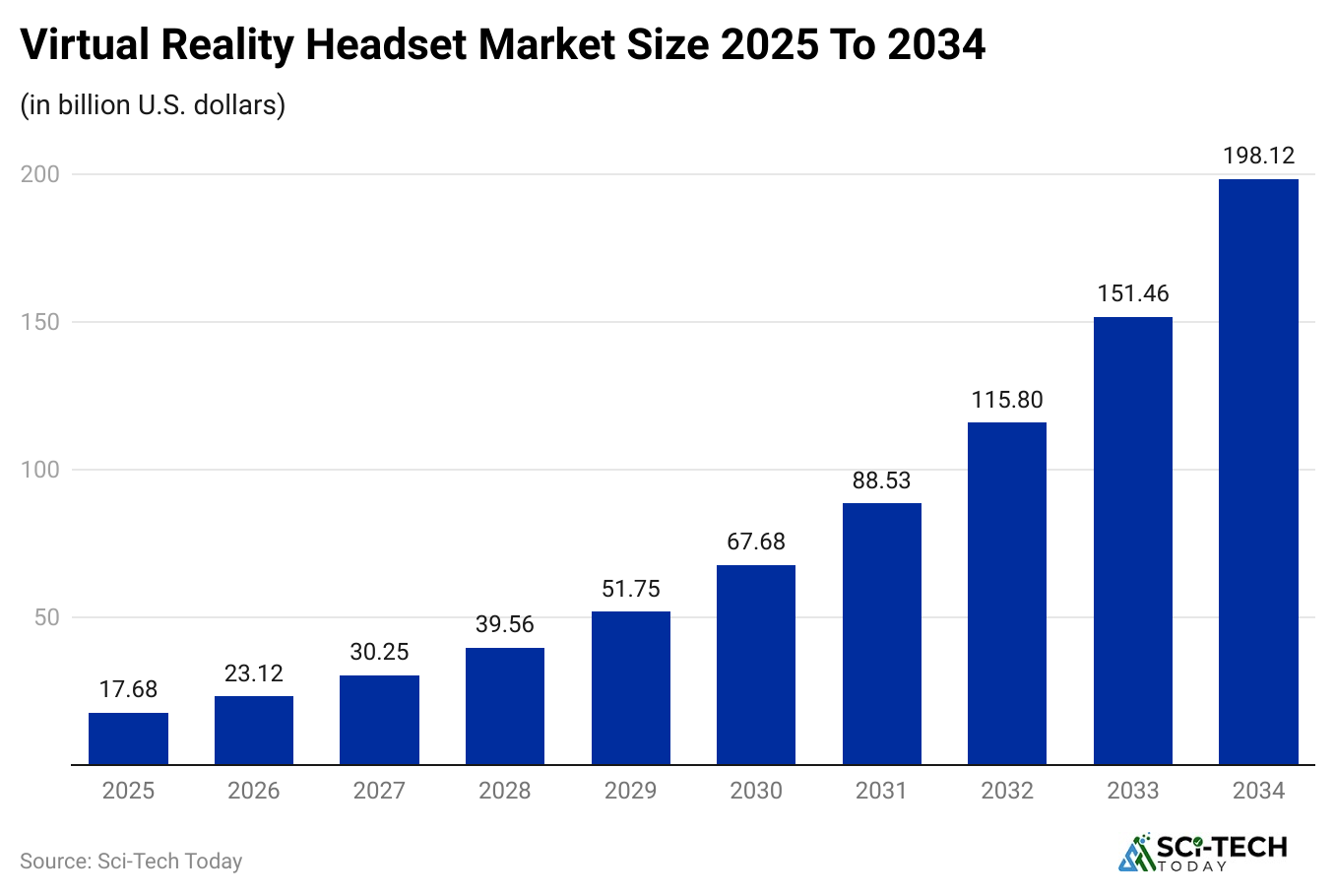
- By the end of 2025, the global market for virtual reality headsets is supposed to reach around USD 17.68 billion.
- Meanwhile, it is expected to grow to USD 198.12 billion by 2034.
- The growth rate of the market will reach a CAGR of 30.8% between 2025 and 2034.
- In 2024, the Asia Pacific earned over half of global VR revenue.
- Besides, standalone headsets brought in 44% of sales, while high-end models led with a 57% share, and gaming made up 30% of usage.
- From 2025 to 2034, affordable devices are expected to grow fast at a 35.3% yearly rate.
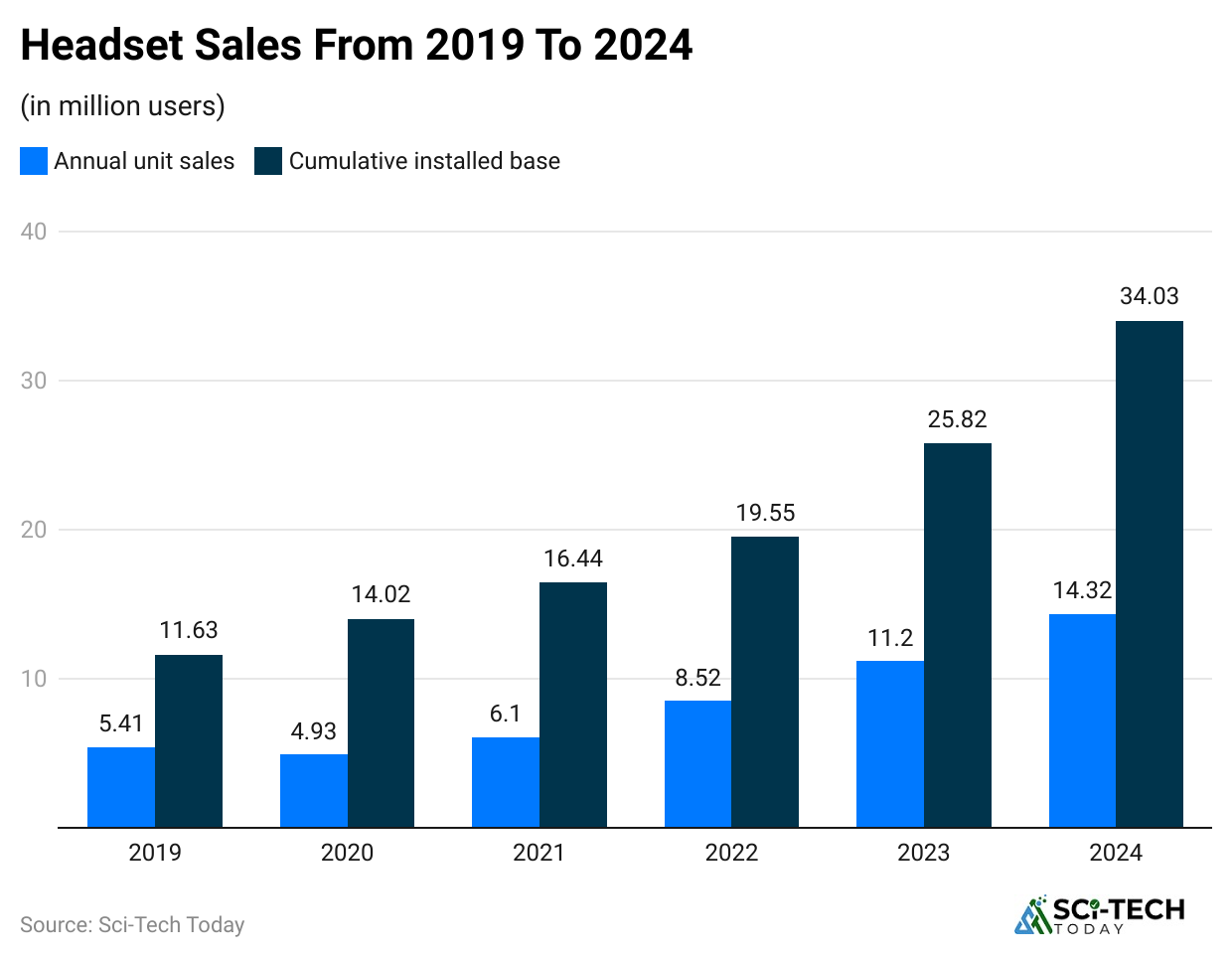
- As of 2024, the cumulative installed base of VR headsets has accounted for 34.03 million unit sales.
- Meanwhile, the annual unit sales resulted in 14.31 million units.
Reasons for Interacting with VR Devices – Statistics
| Reasons | User Share |
| They planned to use VR devices mainly for gaming. |
53% |
| People wanted to find out why everyone was so excited about it. | 33% |
| People usually enjoy staying updated with the latest technology. | 32% |
| A friend or family member suggested buying a VR headset. | 28% |
| VR was either presented or someone else bought it in the household. | 27% |
Complaints about Their VR Devices Statistics
| Complaints | User Share |
| VR gaming has limited options for playing | 17% |
| A VR headset can give serious motion sickness or nausea | 17% |
| Sometime uncomfortable | 16% |
| No such watch options for films or media are available in VR | 14% |
| While connected to a VR, people are not able to use their phones or other devices | 14% |
Reasons for Not Purchasing a VR Device
| Reasons | Share |
| Too Expensive | 46% |
| Don’t play enough games | 25% |
| Don’t see the appeal of VR experiences | 16% |
| No idea how to get started buying one | 15% |
| Worried about motion sickness |
12% |
| Waiting for VR devices to improve in quality | |
| worried about the impact on eyesight |
Social Impact of Virtual Reality Technology Statistics
- A recent survey published by passport-photo. Online shows that 40% of people are most concerned that children might spend too much time in Virtual Reality.
- Another 39% worry it could make users less aware of the real world.
- Others fear issues like online harassment (33%), privacy risks (32%), and more addictive media experiences (32%) as major social problems linked to VR use.
Conclusion
After completing the article on Virtual Reality Statistics, this is no longer just a futuristic concept but is currently becoming part of our everyday lives. VR is now implemented in many sectors like gaming, education, healthcare, and business. Along with rising user adoption, growing investments, and continuous innovation, the global VR market is set to expand rapidly in the coming years.
As the technology is evolving enormously in recent years, VR is now becoming more affordable and widely available, along with reshaping industries and creating experiences that once seemed impossible.
Sources
FAQ.
Ivan Sutherland discovered the first virtual reality system in the 1960s.
There are three types of VR: Non-Immersive Virtual Reality, Semi-Immersive Virtual Reality, and Fully Immersive Virtual Reality.
Using VR for too long can lead to eye strain or motion sickness, so it’s a good idea to take regular breaks.

Joseph D'Souza founded Sci-Tech Today as a personal passion project to share statistics, expert analysis, product reviews, and experiences with tech gadgets. Over time, it evolved into a full-scale tech blog specializing in core science and technology. Founded in 2004 by Joseph D’Souza, Sci-Tech Today has become a leading voice in the realms of science and technology. This platform is dedicated to delivering in-depth, well-researched statistics, facts, charts, and graphs that industry experts rigorously verify. The aim is to illuminate the complexities of technological innovations and scientific discoveries through clear and comprehensive information.









